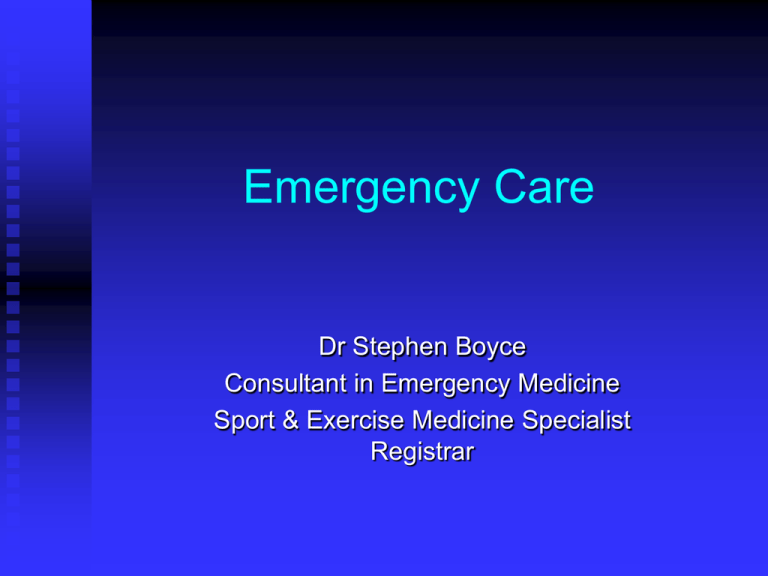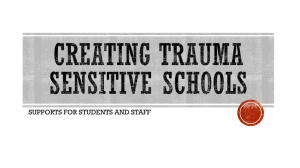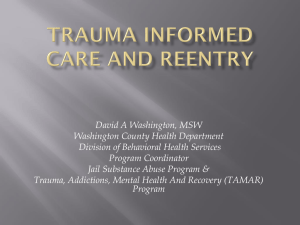Major Traumatic Injuries In Sport
advertisement

Emergency Care Dr Stephen Boyce Consultant in Emergency Medicine Sport & Exercise Medicine Specialist Registrar Definition of Trauma A serious injury or shock to the body, as from violence or an accident. An emotional wound or shock that creates substantial, lasting damage to the psychological development of a person. An event or situation that causes great distress and disruption. “Trauma Centre” Casualty Accident & Emergency (A&E) Emergency Medicine (ED) Workforce Planning Junior doctors ENP’s Registrars Consultants Moving from a “consultant led” service to a “consultant delivered” service What is Trauma ? Major trauma describes serious and often multiple injuries where there is a strong possibility of death and disability. In England, the most common cause is a road accident. The NAO estimates that there are at least 20,000 cases of major trauma each year in England resulting in 5,400 deaths and many others resulting in permanent disabilities requiring long-term care. Causes of Trauma Road traffic accidents (RTA’s) Falls Burns Blunt trauma Penetrating trauma Gunshots Natural disasters, Terrorism Pathway of Trauma Trauma Scores Injury Severity Score (ISS) Anatomical Abbreviated Injury Scale (AIS) 0 - 75 Revised Trauma Score (RTS) Physiological RR, SBP, GCS 0 - 12 Trauma Deaths Immediate Deaths First peak of deaths occurs within seconds or minutes of injury Very few of these patients can be salvaged due to severity of their injuries Only prevention can significantly reduce this peak Early Deaths Occurs within minutes to several hours after injury Intracranial, intrabdominal, multiple fractures, multiple injuries, etc The “Golden Hour” Late Deaths Several days to weeks after the initial injury Sepsis or multiple organ failure The care provided during the “golden hour” will have a direct effect on long term outcome Advance Trauma Life Support (ATLS) Originated in the USA Promoted by the American College of Surgeons (ACS) First course was January 1980 Gradual international recognition re trauma management Adopted in the UK late eighties / early nineties – RCS England ATLS courses in over 42 countries ATLS Concepts Treat greatest threat to life first Lack of a definitive diagnosis should never impede the application of an indicated treatment A detailed history is not essential to begin the evaluation of an acutely injured patient ATLS Objectives Assess the patient’s condition rapidly and accurately Resuscitate and stabilise the patient according to priority Determine if the patient’s needs exceed a facility's capabilities Arrange appropriately for the patient’s interhospital or intrahospital transfer Assure that optimum care is provided ATLS Course Lectures Practical skills MCQ exam Moulage ATLS Moulage Assessment Primary survey Secondary survey Transfer to definitive treatment Primary Survey A B C D E Airway (& C-spine control) Breathing Circulation Disability (Neurological) Exposure Team Approach Monitoring Interventions performed X-rays – Trauma series (C/spine lateral, chest, pelvis) Catheters Further investigations (FAST, USS, CT) Blood tests Secondary Survey Does not begin until the primary survey is complete, resuscitation is established Complete head to toe evaluation Reassessment of all vital signs Further x-rays, blood tests, etc Other specialty review (if not required in primary survey) Transfer Triage Number of casualties exceeds the available resources A process for sorting injured people into groups based on their need for or likely benefit from immediate medical treatment Essential part of major incident planning and preparation Mobile, dynamic process End point of triage is the allocation of a treatment priority Triage Categories Category Description Colour Priority Immediate Immediate life saving treatment Treatment within 6hrs Less serious cases (walking wounded) Non-survivable or exceed resources RED P1 YELLOW GREEN P2 P3 Dead WHITE Urgent Delayed Expectant Dead BLUE Dead Triage Sieve How Can We Improve Trauma Care In Scotland? New STAG audit Consultant delivered care (balanced against resources) Centralisation of services (“trauma centres”) Regular training, skill maintenance, use of simulators, CPD Reflection – M&M meetings Learn from others, eg, military Targeted interventions Emergency Medicine Retrieval Service (EMRS) EMRS Recent Audit 310 emergency retrievals 1/3 trauma 24 lives saved Flying doctors take to the air 25/10/2010 Scotland's 'flying doctor' service is to be rolled out to remote and rural parts of the country, following a successful pilot scheme in the west of Scotland. The service, staffed by air paramedics and consultants who are specialists in emergency medicine, will fly across Scotland to treat critically-ill patients on the spot. Since it began in June 2008, the team has undertaken 565 retrievals and given advice to a further 469 patients. The decision to expand the service was taken after an evaluation of the pilot programme concluded that it offered good quality healthcare, value for money in terms of benefits for patients and significant support for healthcare staff working in remote areas. Health Secretary Nicola Sturgeon said: “Getting the best possible medical help to a critically-ill patient, or someone who has been seriously injured, as rapidly as possible can significantly improve their changes of making a full recovery. "But critical illness or injury can strike anywhere and patients are often some distance from the essential medical treatment they need. That's where the EMRS comes in - experienced accident and emergency or intensive care consultants fly to patients in remote and rural communities. "This early intervention can make the difference between life and death and that is why we have decided to establish Scotland's flying doctors as a national service, delivering first class healthcare to all rural parts of the country." Thank You








